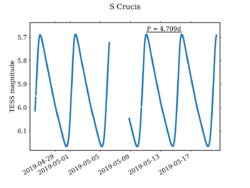Astronomy:S Crucis
From HandWiki
Short description: Variable star in the constellation Crux
| Observation data Equinox J2000.0]] (ICRS) | |
|---|---|
| Constellation | Crux |
| Right ascension | 12h 54m 21.99728s[1] |
| Declination | −58° 25′ 50.2146″[1] |
| Apparent magnitude (V) | 6.22 - 6.92[2] |
| Characteristics | |
| Spectral type | F6-G1Ib-II[2] |
| Variable type | δ Cep[2] |
| Astrometry | |
| Radial velocity (Rv) | −6.10[3] (−21.1 - 5.9)[4] km/s |
| Proper motion (μ) | RA: −9.480[1] mas/yr Dec.: 3.987[1] mas/yr |
| Parallax (π) | 1.0215 ± 0.0448[1] mas |
| Distance | 3,200 ± 100 ly (980 ± 40 pc) |
| Absolute magnitude (MV) | -3.27[5] |
| Details | |
| Radius | 37.9[6] R☉ |
| Surface gravity (log g) | 1.2 - 1.9[4] cgs |
| Temperature | 5,517 - 6,482[4] K |
| Metallicity [Fe/H] | −0.07 - 0.16[4] dex |
| Age | 116[7] Myr |
| Other designations | |
| Database references | |
| SIMBAD | data |

Light curve of the classical Cepheid variable S Crucis recorded by NASA's Transiting Exoplanet Survey Satellite (TESS)
S Crucis is a star in the constellation Crux. A Cepheid variable, its apparent magnitude ranges from 6.22 to 6.92 over 4.68997 d.[2] It is a yellow-white supergiant that pulsates between spectral types F6Ib-II and G1Ib-II.[2]
S Crucis is a pulsating variable star of the δ Cephei type, a Classical Cepheid variable. Its mean radius is 37.9 R☉ and that radius varies by up to 4.1 R☉ during its 4.7-day pulsation cycle.[6] Over the same cycle, the effective temperature varies between 5,517 K and 6,482 K.[4] The star is thought to be 116 million years old; it has exhausted its core hydrogen and left the main sequence.[7]
References
- ↑ 1.0 1.1 1.2 1.3 1.4 Brown, A. G. A. (August 2018). "Gaia Data Release 2: Summary of the contents and survey properties". Astronomy & Astrophysics 616: A1. doi:10.1051/0004-6361/201833051. Bibcode: 2018A&A...616A...1G. Gaia DR2 record for this source at VizieR.
- ↑ 2.0 2.1 2.2 2.3 2.4 Watson, Christopher (4 January 2010). "S Crucis". AAVSO Website. American Association of Variable Star Observers. http://www.aavso.org/vsx/index.php?view=detail.top&oid=10770. Retrieved 12 March 2014.
- ↑ Gontcharov, G. A. (2006). "Pulkovo Compilation of Radial Velocities for 35 495 Hipparcos stars in a common system". Astronomy Letters 32 (11): 759–771. doi:10.1134/S1063773706110065. Bibcode: 2006AstL...32..759G.
- ↑ 4.0 4.1 4.2 4.3 4.4 Proxauf, B.; Da Silva, R.; Kovtyukh, V. V.; Bono, G.; Inno, L.; Lemasle, B.; Pritchard, J.; Przybilla, N. et al. (2018). "A new and homogeneous metallicity scale for Galactic classical Cepheids. I. Physical parameters". Astronomy and Astrophysics 616: A82. doi:10.1051/0004-6361/201833087. Bibcode: 2018A&A...616A..82P.
- ↑ Molinaro, R.; Ripepi, V.; Marconi, M.; Bono, G.; Lub, J.; Pedicelli, S.; Pel, J. W. (2011). "CORS Baade-Wesselink method in the Walraven photometric system: The period-radius and the period-luminosity relation of classical Cepheids". Monthly Notices of the Royal Astronomical Society 413 (2): 942. doi:10.1111/j.1365-2966.2010.18183.x. Bibcode: 2011MNRAS.413..942M.
- ↑ 6.0 6.1 Moskalik, P.; Gorynya, N. A. (2005). "Mean Angular Diameters and Angular Diameter Amplitudes of Bright Cepheids". Acta Astronomica 55: 247. Bibcode: 2005AcA....55..247M.
- ↑ 7.0 7.1 Marsakov, V. A.; Koval', V. V.; Kovtyukh, V. V.; Mishenina, T. V. (2013). "Properties of the population of classical Cepheids in the Galaxy". Astronomy Letters 39 (12): 851. doi:10.1134/S1063773713120050. Bibcode: 2013AstL...39..851M.
- ↑ "V* S Cru". SIMBAD. Centre de données astronomiques de Strasbourg. http://simbad.u-strasbg.fr/simbad/sim-basic?Ident=V%2A+S+Cru.
 |

